BUFFALO 09101457-0 Wireless LAN Router User Manual WZR HP Manual indd
BUFFALO INC. Wireless LAN Router WZR HP Manual indd
BUFFALO >
Contents
- 1. User manual part 1
- 2. User manual part 2
User manual part 2
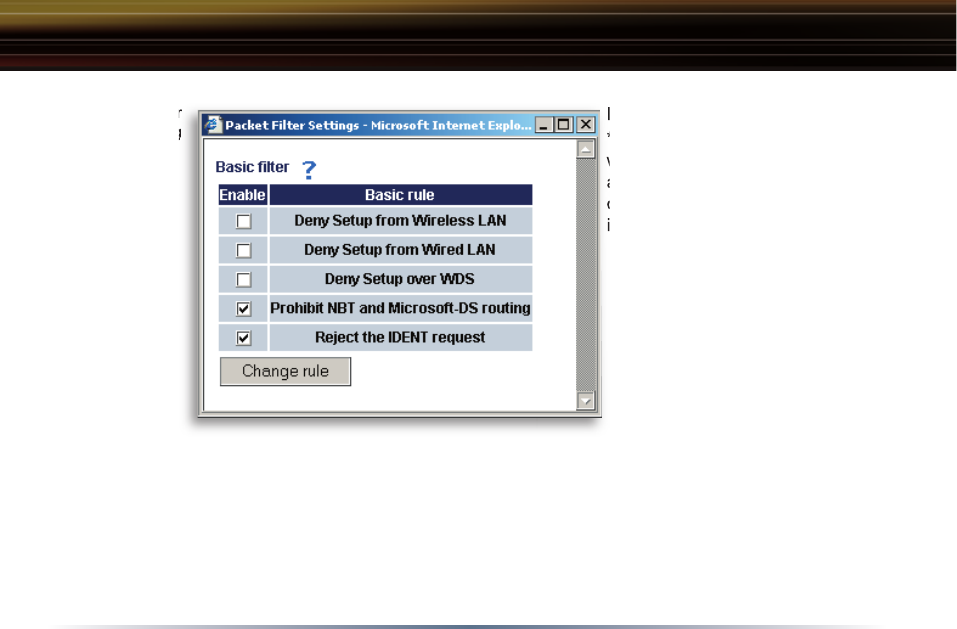
51
FTP and WEB.
* If IDENT requests are for-
warded to a LAN side client by
address translation setting (DMZ
or TCP port :113 ), this basic rule
is ignored.
IP Filter Settings - Up to 32 rules may be made to limit the type of packets allowed to pass
between the WAN and LAN. Each rule may specify that packets meeting specifi c criteria (source
or destination IP Address, Protocol, etc.) from either the WAN or the LAN are ignored, rejected, or
accepted. You may choose that packets from the:
• WAN side (packets coming from the WAN side will be fi ltered)
• LAN side (packets from the LAN side will be fi ltered)
are:
• Ignored (stops the packet and does not route it)
Basic Filter
Setting
FTP and WEB.
* If IDENT requests are for-
warded to a LAN side client by
address translation setting (DMZ
or TCP port :113 ), this basic rule
is ignored.
Basic Filter
Setting
Advanced Settings
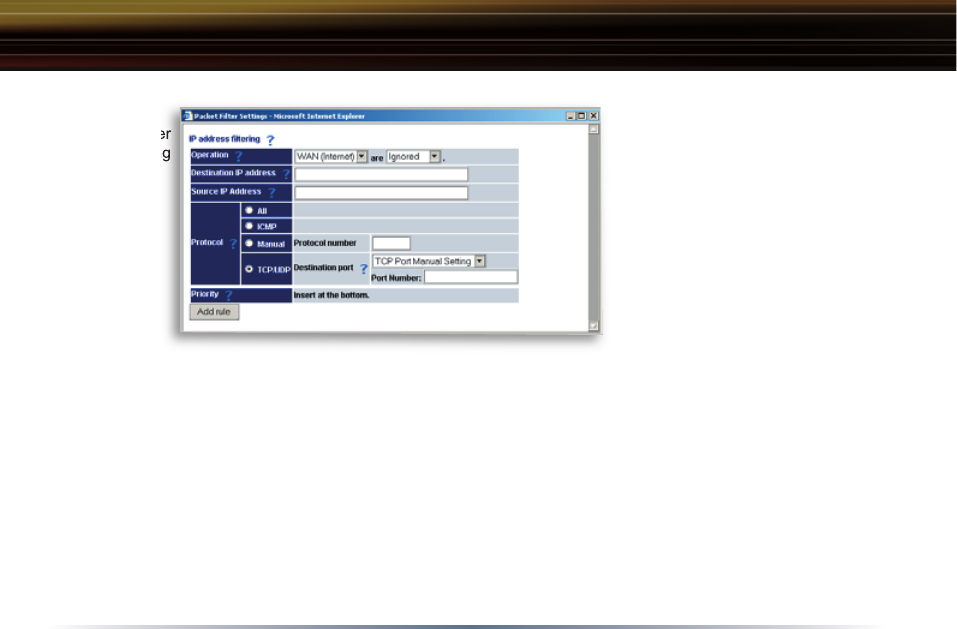
52
• Rejected (returns the rejected
packet to the point of origin)
• Accepted (passes the packet
through)
with each rule. You may also
choose:
• Destination IP Address -
The IP address to be fi ltered.
• Source IP Address - The IP
address designated for fi ltering.
If all IP addresses must be
fi ltered, leave this box blank.
Warning: If administrator makes a rule that all packets from LAN are Ignored or Rejected, they
will no longer have access to the AirStation confi guration screens. This rule prohibits further setup
from a wireless or wired computer. The AirStation can be returned to the factory default settings
by holding down the INIT button on the back of the unit for fi ve seconds or until the red DIAG light
becomes solid.
Protocol - You may also choose to fi lter all protocols, ICMP, arbitrary protocol number, or TCP/
UDP protocol number.
• All - Selects all IP protocols.
IP Filter
setting
IP Filter
setting
Advanced Settings
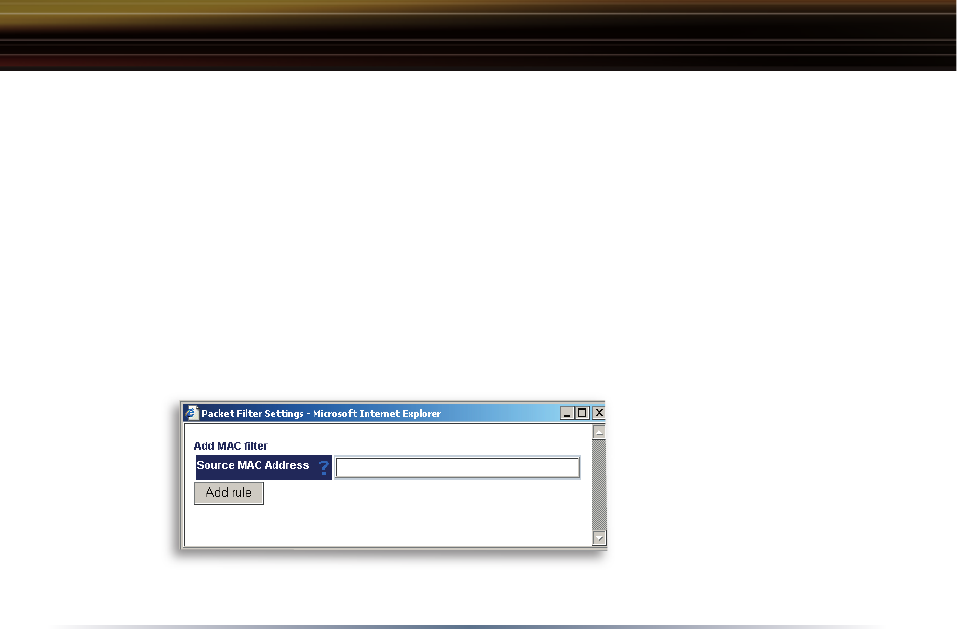
53
• ICMP - Network Diagnostic Protocol (1).
• Manual - Enter protocol number (0-65535).
• TCP/UDP Destination Port - Select TCP or UDP, then enter port number.
Priority - Specify the priority an item. The smaller the number, the higher the priority.
MAC Filter - Click Enter MAC fi lter to enter MAC address.
Source MAC address -The MAC address of the source of the packets that will be fi ltered may be
set. Click Add rule when complete.
■ Note: If confi guring from a wireless computer, add your MAC address to the list of au tho rized
wireless LAN PCs. The MAC address must be in two-digit groups separated by colons.
Example: 00:40:26:00:11:22
Click Apply when settings are
complete.
Advanced Settings
Add MAC
Filter
setting

54
Intrusion Detector
The Intrusion Detector guards against unauthorized access from the WAN (Internet). This function
also records information on unauthorized access attempts
Intrusion Detector - Select Disable, Enable, or Enable (Apply Packet filter setting for Intrusion
Detector setting).
IP Spoofing - Check Block to prevent IP spoofing.
Threshold Value - Enter the number (1-999) of suspect packets to be received before the notifica-
tion occurs.
Advanced Settings
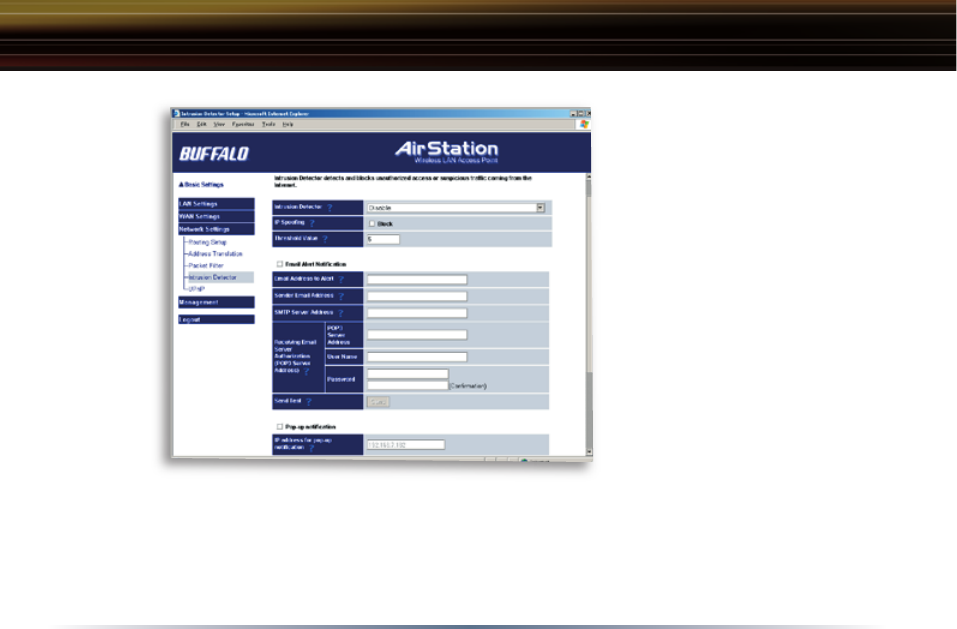
55
Notify by email:
Notifi cation email address - Enter
des ti na tion email address.
Sender email address - Enter the
email address that will send the email.
This is the name that will appear as
the sender when the email is read.
This email can be made up (e.g.
DETECTOR@AIRSTATION).
Intrusion
Detector
Setup
Advanced Settings

56
Sender email server address - Enter the SMTP Server address.
Receiving email server authorization - Enter the POP3 Server address, User name and Password.
This is only required if your SMTP server requires POP verification before it allows email to be sent.
Consult your ISP or mail server support for more information.
Send test - Click Send to test notification; this will also save and commit the entries.
Pop-up notification - Pop-up window alert of unwanted activity. Client Manager must be installed and
running on a client machine to use this feature.
Destination IP address - Enter the IP address to be notified. The LAN computer with this IP address-
must have Buffalo’s Client Manager software installed and running for the verification to occur. If the
machine is off the verification will not be received, and the AirStation will NOT resend information.
Intrusion Detector information - displays log activity detected by the Intrusion Detector service.
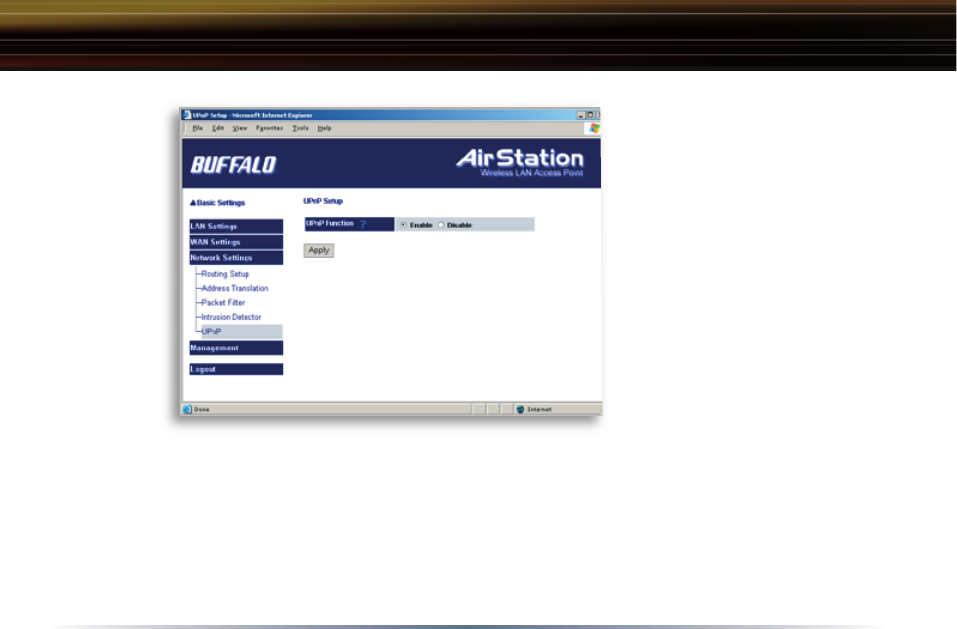
57
UPnP
Select Enable to enable
UPnP (Universal Plug and
Play). When a computer with
UPnP support connects to the
AirStation, that computer auto-
matically receives confi guration
information from the AirStation.
Advanced Settings
UPnP
Setting
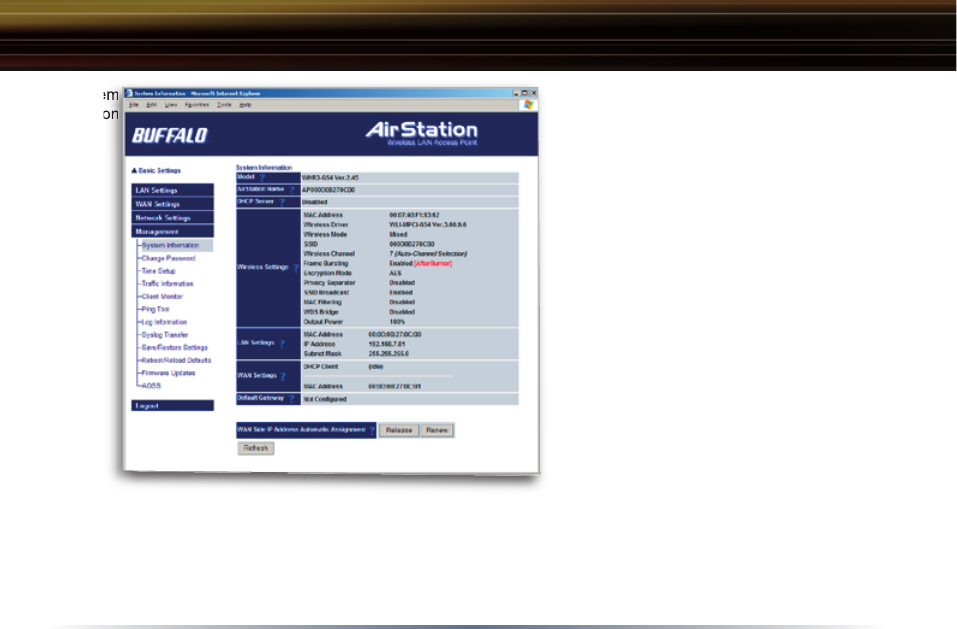
58
Management -
• System Information - System
information of the AirStation is obtained
here.
• Model name - Displays model and
fi rmware version.
• AirStation Name - Displays AirStation
host name.
• DHCP Server function - Displays
whether DHCP is On or Off.
• Wireless - Displays such wireless
LAN settings as wireless MAC address
and wireless fi rmware. The wireless
MAC address is required for setting up
WDS with other access points. This is
the best place to determine the wireless
MAC address. If 125* Mbps AfterBurner
mode is enabled, then the [AfterBurner]
color will be red or grey. When it is red, 125* Mbps AfterBurner is running. When it is grey, 125* Mbps
AfterBurner is enabled but not running due to a client being connected at 54 Mbps or another access point
is running on the same channel.
• LAN - Displays the AirStation LAN settings
• WAN - Displays the AirStation WAN settings
Advanced Settings
System
Information
System
System
Information
Information
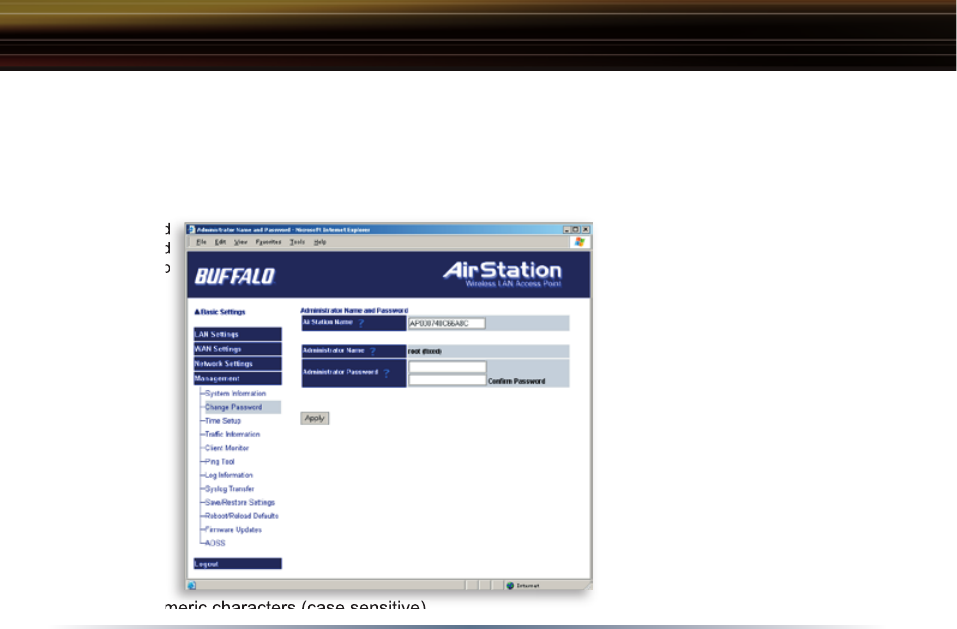
59
• Default Gateway - Displays the default gateway settings
• WAN side IP address auto acquisition - This acquires an IP address from the WAN (Internet)
side DHCP server. Press Release to release current DHCP WAN information. Press Renew to
obtain WAN information from the DHCP server. NOTE: If a manual IP is assigned to the WAN
port, this feature is not displayed.
Admin Name and
Password
• AirStation name - When using
multiple AirStations, select a
unique name to make it easier to
identify each AirStation through
the AirStation Manager utility.
• Administrator name - “root”;
cannot be changed.
• Administrator password -
Allows the administrator to enter
an administrator password to
restrict access to the setting
screens.
• New Password - Enter new
password. Enter up to eight
alphanumeric characters (case sensitive).
Advanced Settings
Name and
Password
Setup
alphanumeric characters (case sensitive).
Name and
Password
Setup
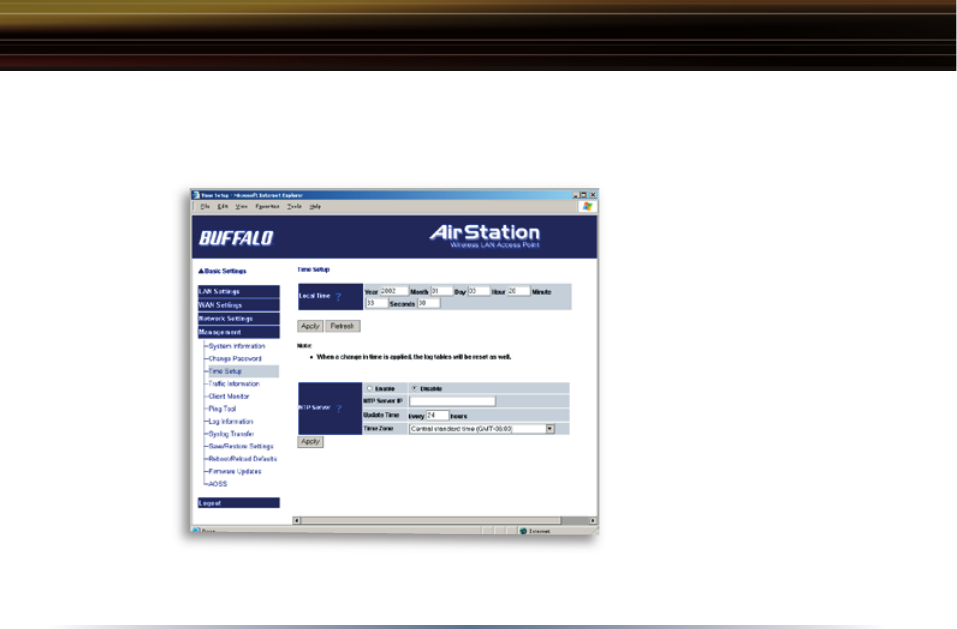
• Confi rm Password - Reenter the new password for confi rmation.
Time setup
Time setup - Enter the current
date and time, and click Set.
NTP - Network Time Protocol.
Select Use or Do not use.
■ Note: If NTP is used, time is
set au to mat i cal ly.
NTP server name - Enter the
NTP server name.
Update Time - Enter the time
interval (in hours) for the time
check frequency.
Time Zone - Select local time
zone.
Click Apply.
Advanced Settings
Time Setup
Screen
60
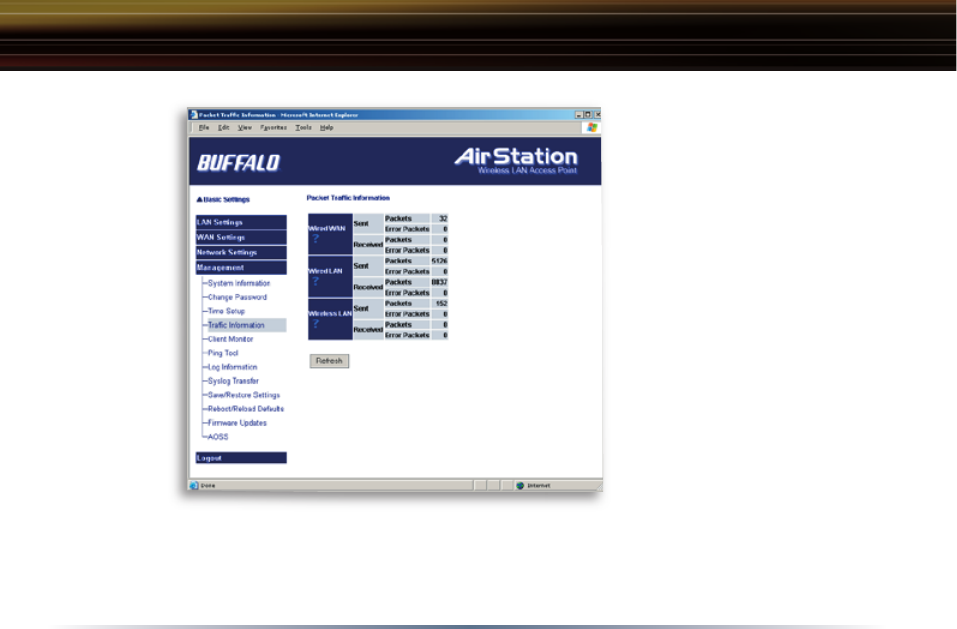
61
Packet Traffi c
Information
Displays number of packets
sent and received for:
Wired WAN
Wired LAN
Wireless LAN
Click Refresh to update the
transfer packet log.
Advanced Settings
Packet Traf-
fi c Informa-
tion
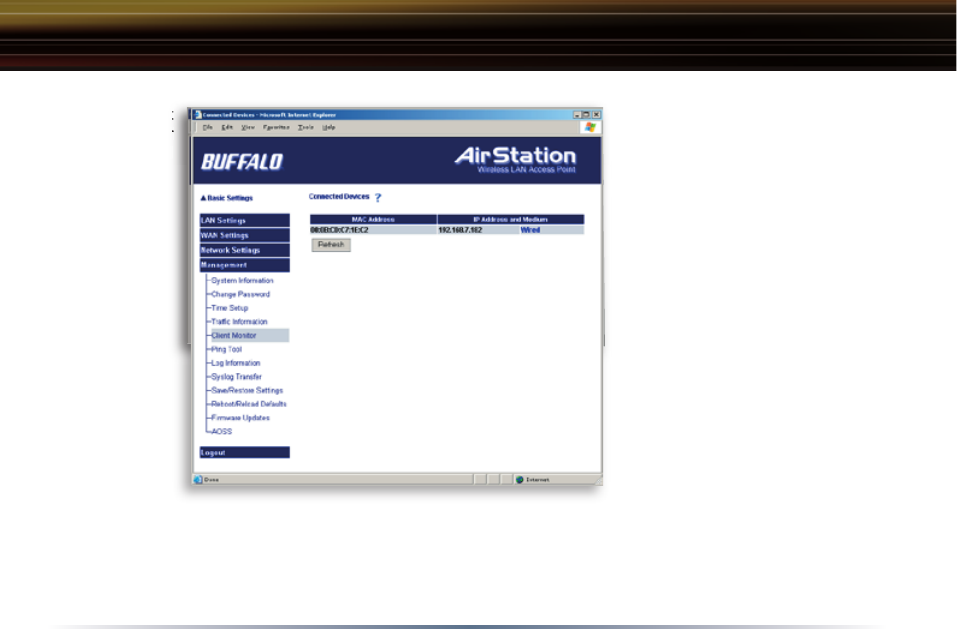
62
Client Monitor
Displays the wired and wireless
clients (computers) that are
accessing the AirStation.
• MAC address - Shows the
client’s MAC address.
• IP Address and Medium -
Shows the IP address that is
assigned to the client from the
DHCP server. The network
medium is shown as ‘wireless’
or ‘wired’ depending on how
the client is accessing the
AirStation.
■ Note: The Client Monitor
only shows clients that have
received an IP address from
the AirStation’s DHCP server.
Clients that have static IP
addresses will not appear in
the Client Monitor.
Advanced Settings
Client
Monitor
Screen
Client
Monitor
Screen
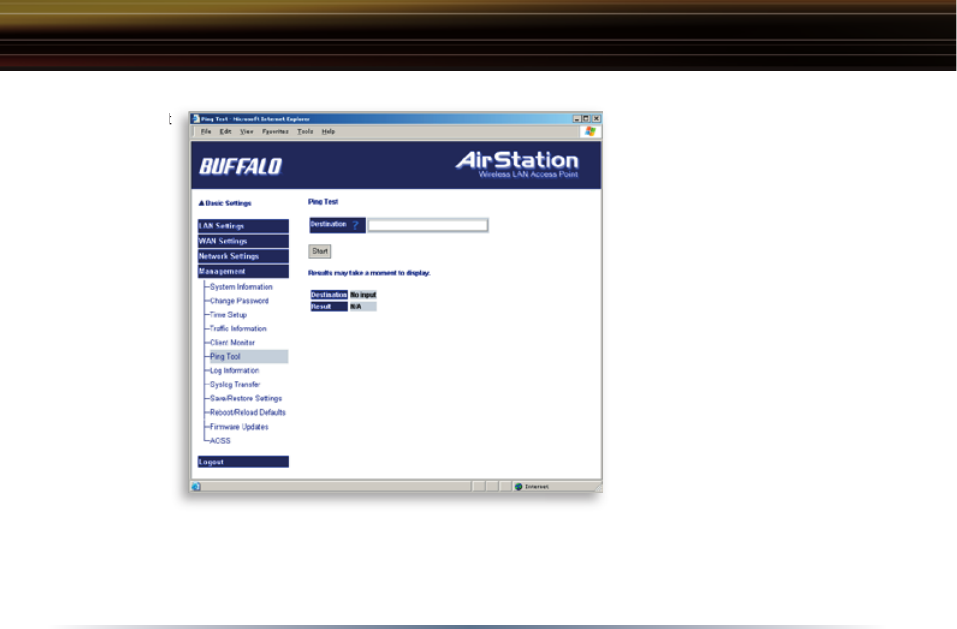
63
PING Test
Performs a PING test from the
AirStation to a LAN or WAN
address.
Enter the target IP address and
click OK (e.g. 192.168.11.2
- OR- www.buffalotech.com)
If the test results in an error,
then verify you correctly
inputted the address and
check your connections.
Advanced Settings
PING Test
PING Test
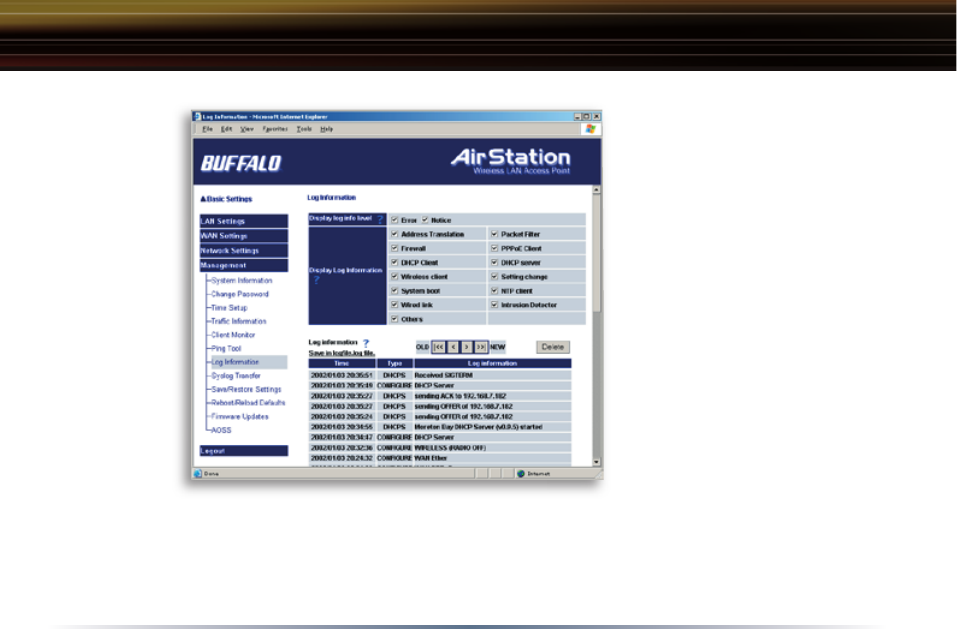
64
Log Information
Display log info level - Select
Error and/or Notify to spec-
ify the types of reports to be
logged by the AirStation.
Display log info - Select the
specifi c reports to be logged.
Log information - Displays
recorded logs.
Advanced Settings
Log
Information
Screen
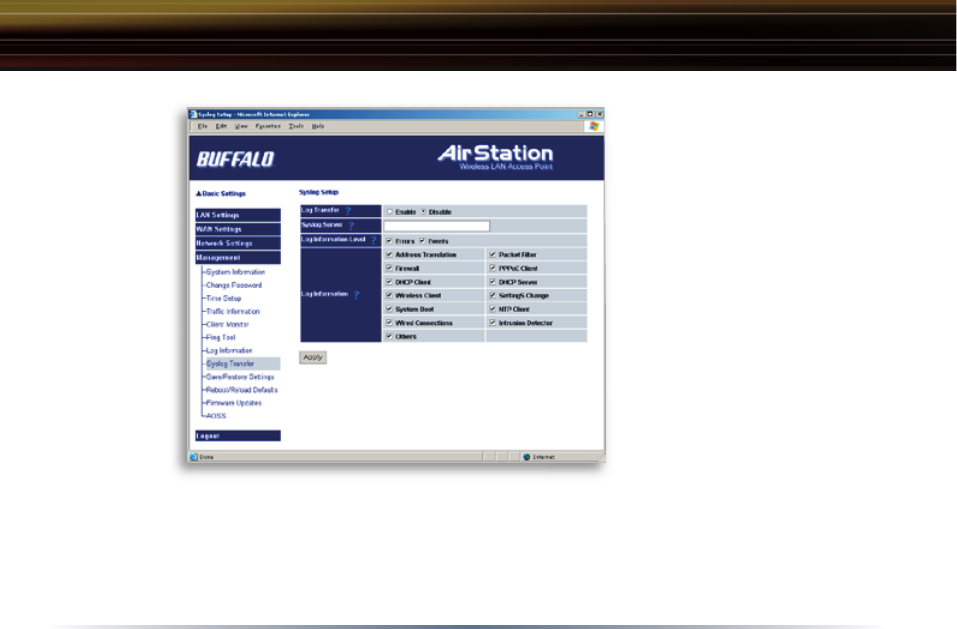
65
Syslog Transfer
Select Use or Do not use
to enable or disable the
AirStation’s ability to transmit
information to a Syslog server.
• Syslog Server - Enter the IP
address of the Syslog server.
• Log Information Level
- Select Error and/or Notice to
specify the types of reports to
be sent to the Syslog server.
• Log Information - Select the
specifi c reports to be sent to
the Syslog server.
■ Note:
A server on the net-
work running a Syslog service
is required for this.
Advanced Settings
Syslog
Transmitting
Screen
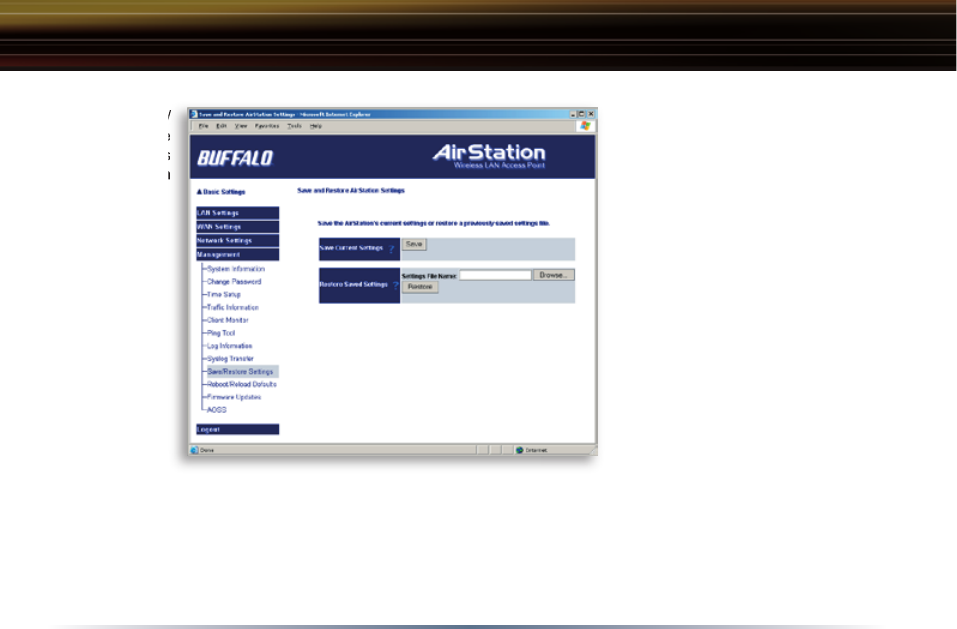
66
Save/Restore Settings
Save current settings - Click
Save to open the fi le saving
dialog and save the current
AirStation settings to a fi le.
Restored saved settings
- Restores settings from a fi le
that has been saved. Click
Choose fi le to select the saved
fi le and click Restore.
■ Note:
If the setting fi le is
saved by a newer fi rmware than
the current one, the AirStation
can’t restore the settings.
Advanced Settings
Save/
Restore
Settings
Screen
Save/
Restore
Settings
Screen
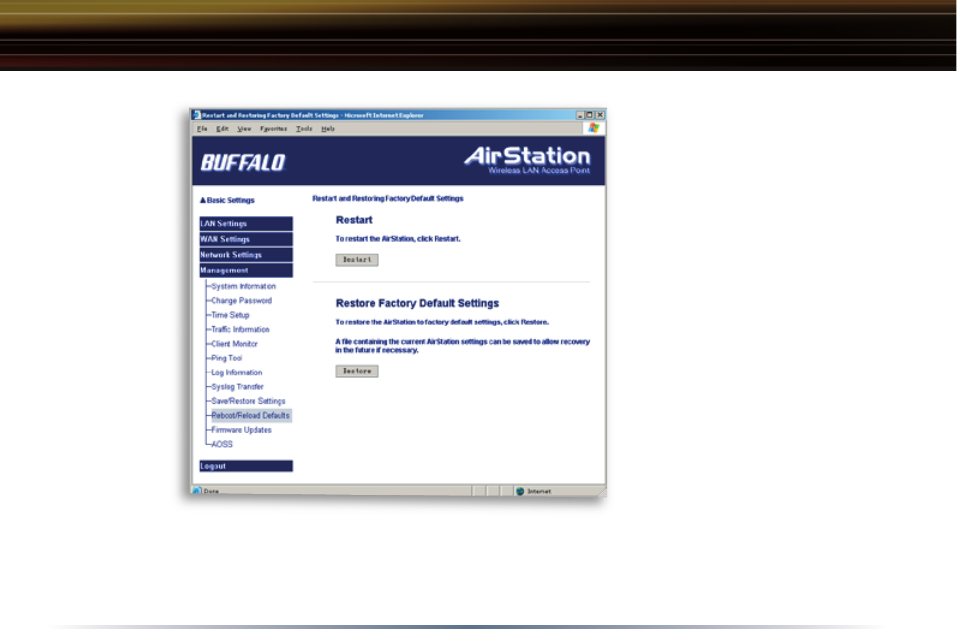
67
Reboot/Reload Defaults
Click Restart to reboot
AirStation.
Click Restore to reset the
AirStation to default factory
settings.
■ Note:
Resetting to default
factory settings will erase
all settings and passwords
previously entered. The
AirStation will return to the
condition it was in when fi rst
purchased.
Advanced Settings
Initialization/
Reboot
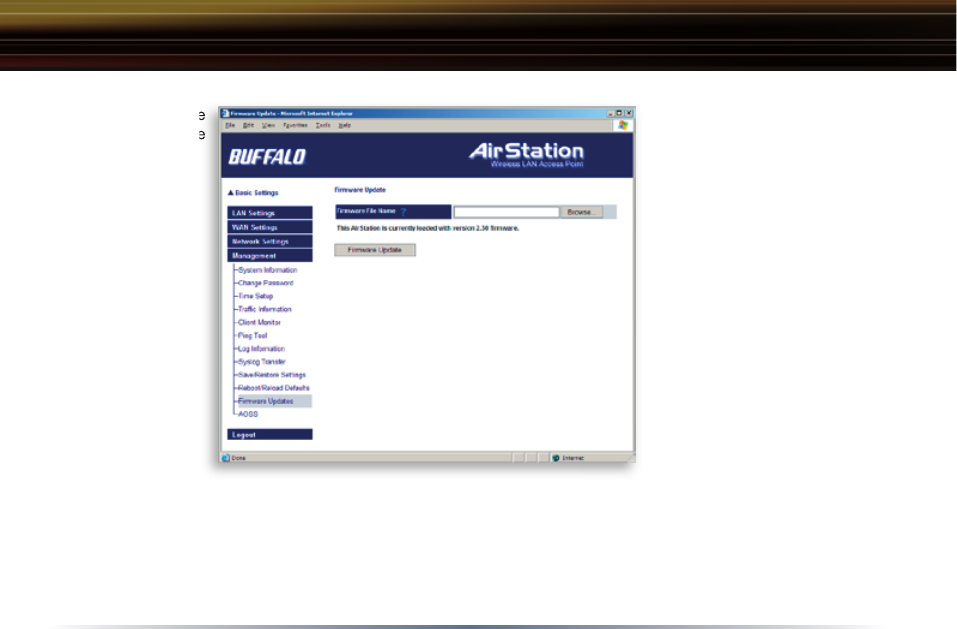
68
Firmware Update
Firmware fi le name
- Click Browse to browse
to the path and fi lename
of the new fi rmware. Click
Firmware Update to load
fi rmware to the AirStation.
■ Note: Firmware update
does not erase current
user settings.
Please visit the Buffalo
Technology Web Page to
download the latest fi rm-
wares free of charge.
http://www.buffalotech.
com/wireless
Advanced Settings
Firmware
Update
Firmware
Update
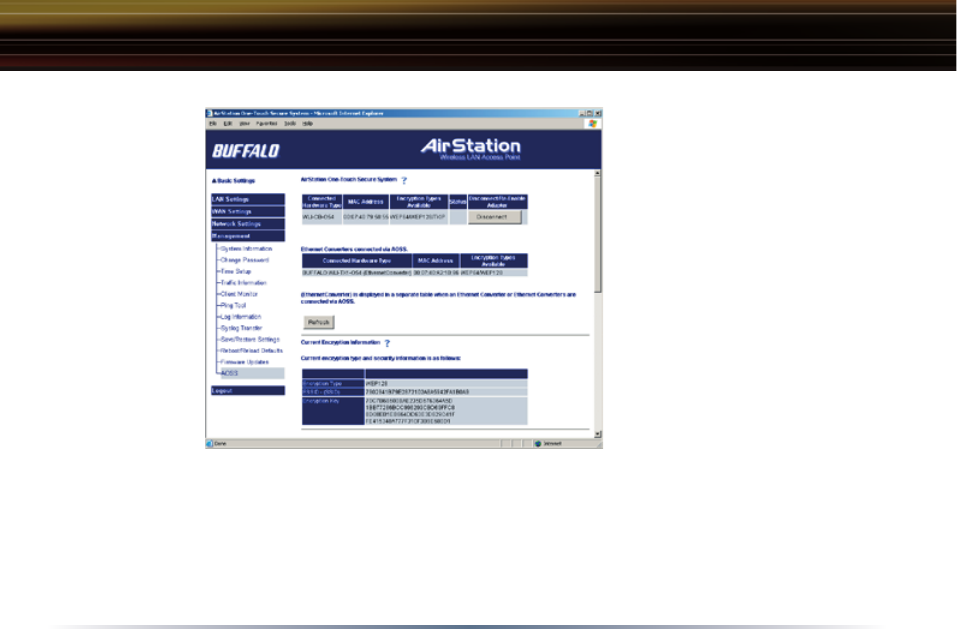
69
AOSS
Client Table - Displays the
clients connected via AOSS. The
‘Disconnect’ button disconnects
the client from the AOSS router
by using MAC Address filtering.
Once disconnected, the client will
still appear in the client list but
will appear as disconnected. The
client can then be re-enabled by
pressing the ‘Re-Enable’ but-
ton. A separate table exists for
connected Ethernet Convertors.
The ‘Refresh’ button updates the
tables.
Advanced Settings
AOSS
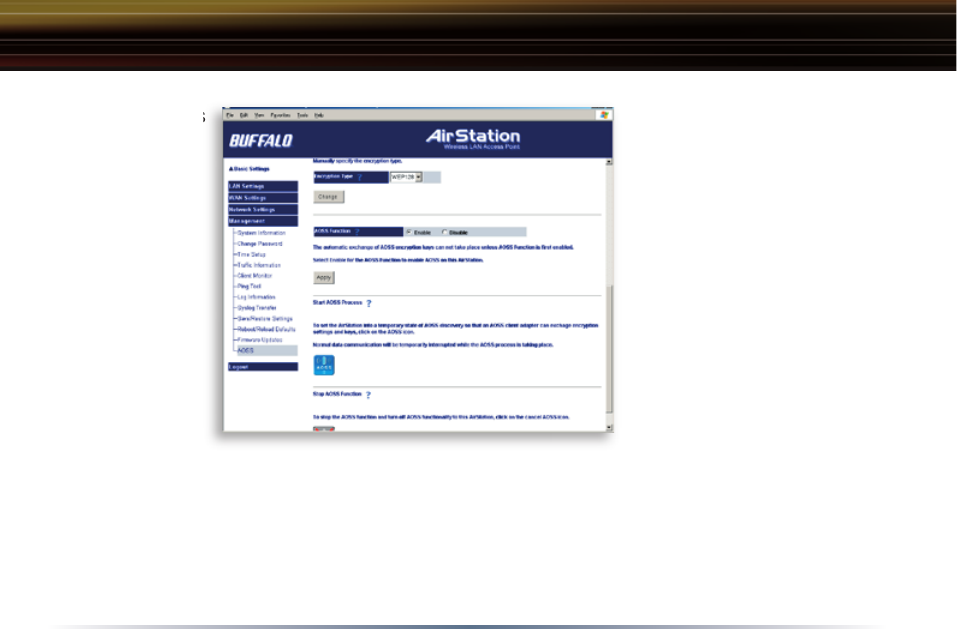
70
Manually specify the encryp-
tion type - This forces AOSS to
use a specifi ed type of encryp-
tion. We recommend that you
not change this setting. If the
setting is changed, then every
client that connects must sup-
port the specifi ed encryption
type.
AOSS Function - Click Enable
to allow the AirStation to use
AOSS. Click Disable to disable
the AOSS system. button on
the AirStation.
Advanced Settings
Start AOSS Process- Click AOSS icon to begin the AOSS sequence. This starts the AOSS process
just like pressing the AOSS button.
Stop AOSS Process- Click AOSS icon to stop AOSS operation. Stopping the AOSS function will turn
off AOSS and return the router to non-AOSS function.
AOSS
AOSS

71
Additional Information
For more information, please consult:
• The AirStation website at:
http://www.buffalotech.com - for frequently asked questions (FAQ’s) and Software Updates.
WZR-HP-G54 BASE STATION SPECIFICATIONS
Physical Specifications
Dimensions W3 x H6.75 x D6.1in. (76 x 171 x 155mm)
Weight 1 lb. (620g)
Temperature & Humidity
Operation 0˚ to 40˚ C
Maximum humidity 80%
Transit/Storage 0˚ to 40˚ C maximum humidity 80% (no condensation)
Power Characteristics
Transmit Mode 1.1A (Nominal),
Power Supply 3.3 V
Specifications

72
Regulatory Information
Wireless communication is often subject to local radio regulations. Although AirStation wireless
networking products have been designed for operation in the license-free 2.4 GHz band, local radio
regulations may impose limitations on the use of wireless communication equipment.
Networking Characteristics
Compatibility
• IEEE802.11g/b Standard for Wireless LANs (125* High-Speed Mode also Available)
• Wi-Fi (Wireless Fidelity) certified by the Wi-Fi Alliance.
Host Operating System
Microsoft Windows® 98SE/ME/NT4.0/2000/XP, Unix, Linux and MacOS
Media Access Protocol
Wired - CSMD/CD (Collision Detection)
Wireless - CSMD/CA (Collision Avoidance) with Acknowledgment (ACK)
Radio Characteristics
RF Frequency Band 2.4 GHz (2400-2483 MHz)
11 selectable channels (3 non-overlapping)
Specifications

74
Modulation Technique Direct Sequence Spread Spectrum
• ODFM for High Transmit Rate
• DQPSK for Standard Transmit Rate
• DBPSK for Low Transmit Rate
Spreading 11-chip Barker Sequence
Nominal Output Power 25.0 dBm
Transmit Rate / Range
High Speed 54 Mbps (125* Mbps in 125* High-Speed Mode)
Medium Speed 36 Mbps (96 Mbps in 125* High-Speed Mode)
Standard Speed 2 Mbps
Low Speed 1 Mbps
Open Office Environment
160 m (525 ft.)
270 m (885 ft.)
Specifications

74
400 m (1300 ft.)
550 m (1750 ft.)
Semi-Open Office Environment
50 m (165 ft.)
70 m (230 ft.)
90 m (300 ft.)
115 m (375 ft.)
Closed Office
25 m (80 ft.)
35 m (115 ft.)
40 m (130 ft.)
50 m (165 ft.)
Receiver Sensitivity -83 dBm -87 dBm -91 dBm -94 dBm (depends on data rate)
Delay Spread (at FER of <1%) 65 ns 225 ns 400 ns 500 ns (depends on data rate)
• The range of wireless devices can be affected by metal surfaces, solid high-density materials
and obstacles in the signal path.
Specifications

75
Table “Radio Characteristics” lists the typical ranges when used indoors:
• In Open Office environments, clients can “see” each other, i.e. there are no physical obstruc-
tions between them.
• In Semi-open Office environments, work space is separated by room dividers; client cards are
at desktop level.
• In Closed Office environments, workspace is separated by floor-to-ceiling brick walls.
■ Note:
The range values listed in Table “Radio Characteristics” are typical distances as
measured at Buffalo Technology AirStation laboratories. These values are provided for your
guidance but may vary according to the actual radio conditions at the location where the AirStation
product is installed.
AirStation IEEE 802.11 Channel Sets
The range of the wireless signal is related to the Transmit Rate of the wireless communication.
Communications at a lower Transmit range may travel longer distances.
Center Channel ID FCC
1 2412 2 2417 3 2422 4 2427 5 2432 6 2437 7 2442 8 2447 9 2452 10 2457 11 2462
11 default channel
Specifications

76
Common Problems:
• Out of range, client cannot connect to the AirStation.
• Configuration mismatch, client cannot connect to the AirStation.
• Absence or conflict with the Client Driver.
• Conflict of another device with the AirStation hardware.
B.1.1 LED Activity B
Monitoring LED activity helps identify problems.
• Power LED should be GREEN,
• Wireless LED should be GREEN if the line is active. If is it blinking GREEN, wireless communica-
tion is active.
• Ethernet LED should be GREEN (100Mbps) or AMBER (10Mbps) while the communication is ac-
tive.
DIAG LED Activity
Unplug the power for three seconds. Plug the power back in to monitor the DIAG LEDs during start-up.
If any symptoms match section B.1.1, call the Buffalo Tech Support line 24 hours a day, 7 days a week
at 866-752-6210 or email info@buffalotech.com.
Troubleshooting
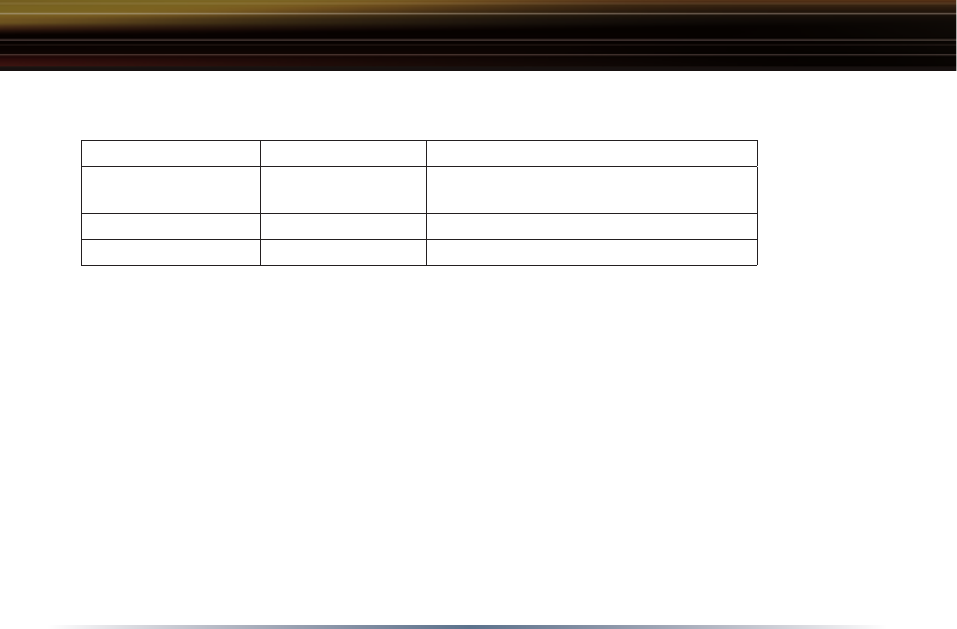
77
Table B.1.1 DIAG LED Activity Table
DIAG LED Display Time Description/Action
Continuous Red Starting RAM Error Red flash, 2 times Starting Flash ROM
Error
Red flash, 3 times Starting A problem on the wired LAN side
Red flash, 4 times Starting A problem on the wireless LAN side
B. 1.2 LEDs Work But Client PC Cannot Connect to Network
If the LEDs indicate that the network is working properly (Power LED is on, Transmit/Receive LED
blinks), check the TCP/IP settings of the network.
Changing Client TCP/IP Settings in Windows
Consult the LAN Administrator for TCP/IP settings.
To add or change the TCP/IP Settings:
1. On the Windows task bar click Start.
2. Select Settings, then Control Panel.
3. Double-click on the Network icon to view the Network Properties.
4. From the list of installed components, verify the TCP/IP => wireless LAN adapter protocol is
installed.
Troubleshooting

78
• If the wireless adapter protocol is not yet installed, click the Add button and select the TCP/IP
protocol from the list. Refer to Windows Help for more information.
• If the wireless adapter protocol is installed, select the protocol and click the Properties button.
Verify the parameters match the settings provided by your LAN Administrator. Make changes
if necessary, and click OK.
5. When or if prompted, restart your computer.
B. 1.3 Other Problems
Please refer to www.buffalotech.com for further reference materials.
Troubleshooting

79
Troubleshooting WDS (Step-by-Step Instructions)
The most common issue with WDS installations is using the wrong MAC address. The proper MAC Ad-
dress for the access points is the ‘Wireless MAC Address’. The best place to document this is under the
‘System Information’ section of the configuration web page. For proper setup, please continue reading
this document.
Problem:
Communication problems with WDS (wireless bridging/repeating).
Cause:
WDS is a very complex bridging system, and is not part of the 802.11b or 802.11g standards.
Restrictions:
Please verify that the following conditions are met (if just one condition is not satisfied, then WDS can-
not be used on the wireless network):
1. All wireless access points in the wireless bridge need to be from the same vendor (e.g. all Buffalo
access points).
(At time of publication, the Apple Airport Extreme WILL work in WDS with Buffalo G54 access points.)
2. No single access point can communicate with more then six other access points in the wireless
bridge.
Troubleshooting

80
The following is a list of good practices with WDS:
1. Start the wireless bridge system with only two access points and then add more access points.
2. Setup all access points in the wireless bridge in close proximity before they are deployed to their
proper location.
3. Only one access point in the wireless bridge should be serving DHCP and routing services unless a
routed wired network exists.
Proper Setup:
Please follow the following steps to properly setup WDS.
1. It is recommended that all access points in the bridge are reset to their factory default settings. This
is done by holding the INIT button on the rear of the access point down for 5-10 seconds.
2. Login to the first access point in the wireless bridge (this should be the DHCP server enabled ac-
cess point if there is not already a routed wired network).
3. Click on the ‘Advanced’ button.
4. The wireless settings page will appear. Select the proper settings for the wireless network. Record
all settings on a piece of paper. All settings except for the SSID need to be identical amongst all
access points in the bridge. If roaming is desired, then make sure the SSID settings are identical
as well. Press the ‘Apply’ button after any changes are made. If the IP address was changed, then
reconnecting to the access point for configuration will require accessing it via its new IP address in a
web browser (e.g. http://NEW_IP_ADDRESS).
5. Click on the ‘LAN port’ link on the left.
Troubleshooting

81
6. Check that the ‘LAN side IP address’ values are correct for your network, or leave them as default.
Record the ‘LAN side IP address’. Press the ‘Apply’ button if any settings on this page have been
changed.
7. Click on the ‘Management’ link on the left.
8. The System Information page will appear. In the Wireless section of the table record the MAC
address, including the colons (i.e. “00:00:0A:1B:2C:DF”). Please make sure the MAC address is
recorded from the Wireless section and not the other sections.
9. Logout of the access point by clicking on the ‘Logout’ link on the left. Close the browser window.
10. Login to the second access point in the wireless bridge.
11. Click on the ‘Advanced’ button.
12. The wireless settings page will appear. Select the proper settings for the wireless network. Refer to
the settings recorded from the first access point. All settings except for the SSID need to be identical
for all access points in the bridge. If roaming is desired, then make sure the SSID settings are identi-
cal as well.
13. Click on the ‘LAN port’ link on the left.
14. Make sure that the ‘IP address’ for the ‘LAN side IP address’ setting is different from that of the first
access point. The IP addresses cannot be the same, but they should be on the same network. It is
recommended that the IP address of the second access point is one higher then that of the first ac-
cess point. Thus, if access point one’s address is 1.1.1.1, then access point two’s address should be
1.1.1.2. If there is a ‘DHCP server function’ setting on this page, then make sure to set it to ‘Disabled’.
Press the ‘Apply’ button when finished.
Troubleshooting

82
15. Click on the ‘Wireless bridge (WDS)’ link on the left.
16. Enable the WDS function and press the ‘Set’ button.
17. Enter the Wireless MAC Address of the first access point (which was recorded on Step 8) into the
field that say ‘MAC Address of AirStation(Wireless)’ (include the :’s). Press the ‘Add’ button.
18. The Wireless MAC address inputted on the step above will appear in the ‘Connected AirStation’
table. Please check that the checkbox under enable is checked, and then press the ‘Enable marked
item’ button.
19. At the top of the page, press the ‘Apply’ button.
20. Once the router has rebooted, click on the ‘Management’ tab on the left.
21. The System Information page will appear. In the Wireless section of the table record the MAC ad-
dress (including the :’s). Please make sure the MAC address is recorded from the Wireless section
and not the other sections.
22. Logout of the access point by clicking on the ‘Logout’ link on the left. Close the browser window.
23. Login to access point one again.
24. Click on the ‘Advanced’ button.
25. Click on the ‘Wireless bridge (WDS)’ link on the left.
26. Enable the WDS function and press the ‘Apply’ button.
27. Enter the Wireless MAC Address of the first access point (which was recorded on Step 21) into the
field that say ‘MAC Address of AirStation(Wireless)’ (include the :’s). Press the ‘Add’ button.
Troubleshooting

83
29. At the top of the page, press the ‘Apply’ button.
30. Once the router has rebooted, click on the ‘Management’ tab on the left.
31. Click on the ‘PING test’ link on the left.
32. In the ‘Destination’ field enter the IP address of the second access point and press the ‘OK’ button.
a. If the ‘Result’ section of the table reports information like, “1st: 64 bytes from IP_ADDRESS” then
the WDS bridge is effectively working.
b. If the ‘Result’ section of the table reports “Destination Host Unreachable”, then an error has oc-
curred during the setup.
WDS is a complicated bridging system with a lot of variables. If there are still problems with WDS con-
figuration on the network, then please call our 24/7 technical support line at 1-866-752-6210.
Troubleshooting

84
10BaseT or 100BaseTx: 802.3 based Ether-
net network that uses UTP (Unshielded twisted
pair) cable and a star topology. 10 is 10 Mbps
and 100 is 100 Mbps.
802.1x: The standard for wireless LAN authenti-
cation used between an AP and a client. 802.1x
with EAP will initiate key handling.
Ad-Hoc Network: The wireless network based
on a peer-to-peer communications session.
Also referred to as AdHoc.
Bandwidth: The transmission capacity of a
computer or a communication channel, stated in
Megabits per second (Mbps).
BSS (Basic Service Set): An 802.11 network-
ing framework that includes an Access Point.
Bus Mastering: A system in which the speci-
fied Input/Output device (e.g. NIC Card) can
perform tasks without the intervention of the
CPU.
Client: A PC or workstation on a network.
Cross-Over Cable: A UTP cable that has its
transmit and receive pair crossed to allow com-
munications between two devices.
DCE (Data Communications Equipment):
Hardware used for communication with a Data
Terminal Equipment (DTE) device.
Default Gateway: The IP Address of either the
nearest router or server for the LAN.
Default Parameter: Parameter set by the
manufacturer.
Destination Address: The address portion of
a packet that identifies the intended recipient
station.
DHCP (Dynamic Host Configuration Pro-
tocol): Based on BOOTP, it uses a pool of IP
addresses, which it assigns to each device con-
nected to it, and retrieves the address when the
device becomes dormant for a period of time.
DNS (Domain Name System): System used
to map readable machine names into IP ad-
dresses
Glossary

85
Driver: Software that interfaces a computer
with a specific hardware device.
DSSS (Direct Sequence Spread Spectrum):
Method of spreading a wireless signal into wide
frequency bandwidth.
DTE (Data Terminal Equipment): Device that
con10BaseT or 100BaseTx: 802.3 based
Ethernet network that uses UTP (Unshielded
twisted pair) cable and a star topology. 10 is 10
Mbps and 100 is 100 Mbps.
Dynamic IP Address: An IP address that is
automatically assigned to a client station in a
TCP/IP network, typically by a DHCP server.
ESS (Extended Service Set): A set of two
or more BSSs that form a single sub-network.
SSID is user identification used in the ESS LAN
configuration.
Ethernet: The most widely used architecture
for Local Area Networks (LANs). It is a shared-
media network architecture. The IEEE 802.3
standard details its functionality.
Ethernet cable: A wire similar to telephone
cable that carries signals between Ethernet
devices.
File and Print Sharing: A Microsoft application
that allows computers on a network to share
files and printers.
Firmware: Programming inserted into program-
mable read-only memory, thus becoming a
permanent part of a computing device.
Frame: A fixed block of data, transmitted as a
single entity. Also referred to as packet.
Full-Duplex: To transmit on the same channel
in both directions simultaneously.
Half-duplex: To transmit on the same channel
in both directions, one direction at a time.
Hub: A device which allows connection of com-
puters and other devices to form a LAN.
IEEE (Institute of Electrical and Electronics
Engineers): The professional organization
which promotes development of electronics
technology.
Glossary

86
IP (Internet Protocol) Address: A unique 32-
binary-digit number that identifies each sender
or receiver of information sent in packets.
Infrastructure: A wireless network or other
small network in which the wireless network
devices are made a part of the network through
the Access Point.
ISP (Internet Service Provider): A company
that provides access to the Internet and other
related services.
IV (Initialization Vector): The header section
of an encrypted message packet.
LAN (Local Area Network): A group of com-
puters and peripheral devices connected to
share resources.
LED (Light Emitting Diode): The lights on
a hardware device representing the activity
through the ports.
MAC (Medium Access Control) Address:
A unique number that distinguishes network
cards.
Mbps (Mega Bits Per Second): A measure-
ment of millions of bits per second.
MDI/X (Media Dependent Interface/Cross-
over): Port on a network hub or switch that
crosses the incoming transmit lines with the
outgoing receive lines.
MHz (MegaHertz): One million cycles per
second.
NAT (Network Address Translation): An inter-
net standard that enables a LAN to use one set
of IP addresses for internal traffic and a second
set for external traffic.
NIC (Network Interface Card): An expansion
card connected to a computer so the computer
can be connected to a network.
Packet: A block of data that is transferred as a
single unit, also called a frame or a block.
Packet Filtering: Discarding unwanted net-
work traffic based on its originating address or
its type.
Glossary

87
mation between computers.
RADIUS (Remote Authentication Dial In User
Service): A server that issues authentication keys
to clients.
RAM (Random Access Memory): Non-permanent
memory.
Repeater Hub: A device that receives, strength-
ens and re-transmits information to all connected
devices, allowing the network to be extended to
accommodate additional workstations.
RC4: The encryption algorithm that is used in WEP.
RJ-45 connector: An 8-pin connector used be-
tween a twisted pair cable and a data transmission
device.
ROM (Read Only Memory): Permanent memory.
Router: Device that can connect individual LANs
and remote sites to a server.
Roaming: The ability to use a wireless device while
moving from one access point to another without
losing the connection.
PCI (Peripheral Component Interconnect): A
bus that is connected directly to the CPU.
PCMCIA (Personal Computer Memory Card
International Association) Card: Remov-
able module that adds features to a portable
computer.
Ping (Packet Internet Groper): An Internet
utility used to determine whether a particular IP
address is online.
Plug and Play: Hardware that, once in-
stalled (“plugged in”), can immediately be
used (“played”), as opposed to hardware that
requires manual configuration.
PoE (Power over Ethernet): A mechanism
to send DC power to a device using a CAT5
Ethernet cable.
PPPoE (Point-to-Point Protocol over Ether-
net): A specification for connecting users on an
Ethernet line to the Internet through a common
broadband medium.
Protocol: A standard way of exchanging infor-
Glossary

88
Script: A macro or batch file containing instruc-
tions and used by a computer to perform a task.
Server: Any computer that makes files or
peripheral devices available to users of the
network and has a resident Network OS.
SMTP (Simple Mail Transfer Protocol): The
protocol used to define and deliver electronic
mail (E-mail) from one location to another.
SNMP (Simple Network Management Proto-
col: An application layer protocol that outlines
the formal structure for communication among
network devices.
Static IP Address: A permanent IP address is
assigned to a node in a TCP/IP network. Also
known as global IP.
STP (Shielded Twisted Pair): Twisted Pair
cable wrapped in a metal sheath to provide ex-
tra protection from external interfering signals.
Subnet Mask: An eight-byte address divided
into 4 parts separated by periods.
TCP/IP (Transmission Control Protocol/In-
ternet Protocol: Protocol used by computers
when communicating across the Internet or
Intranet.
TKIP (Temporal Key Integrity Protocol): An
encryption method replacing WEP. TKIP uses
random IV and frequent key exchanges.
Topology: The shape of a LAN (Local Area
Network) or other communications system.
Twisted Pair: Cable that comprises 2 or more
pair of insulated wires twisted together.
UDP (User Datagram Protocol): A com-
munication method (protocol) that offers a
limited amount of service when messages are
exchanged between computers in a network.
UDP is used as an alternative to TCP/IP.
Uplink: Link to the next level up in a communi-
cation hierarchy.
UTP (Unshielded Twisted Pair) cable: Two or
more unshielded wires twisted together to form
a cable.
Glossary

89
WAN (Wide Area Network): A networking sys-
tem covering a wide geographical area.
WEP (Wired Equivalent Privacy): An encryp-
tion method based on 64 or 128-bit algorithm.
Web Browser: A software program that allows
viewing of web pages.
Wi-Fi (Wireless Fidelity): An organization that
tests and assures interoperability among WLAN
devices.
Wire Speed: The maximum speed at which a
given packet can be transferred using Ethernet
and Fast Ethernet standard specifications.
WLAN (Wireless LAN): A LAN topology using
wireless devices.
VPN (Virtual Private Network): A security
method to connect remote LAN users to a cor-
porate LAN system.
Glossary

90
Disclaimer
* 125 High-Speed Mode: When operating in High-Speed Mode™, this Wi-Fi device achieves
an actual wireless network data transfer rate of up to 34.1Mbps, which is the equivalent data
transfer rate of a system following 802.11g protocol and operating at a signaling rate of 125
Mbps.
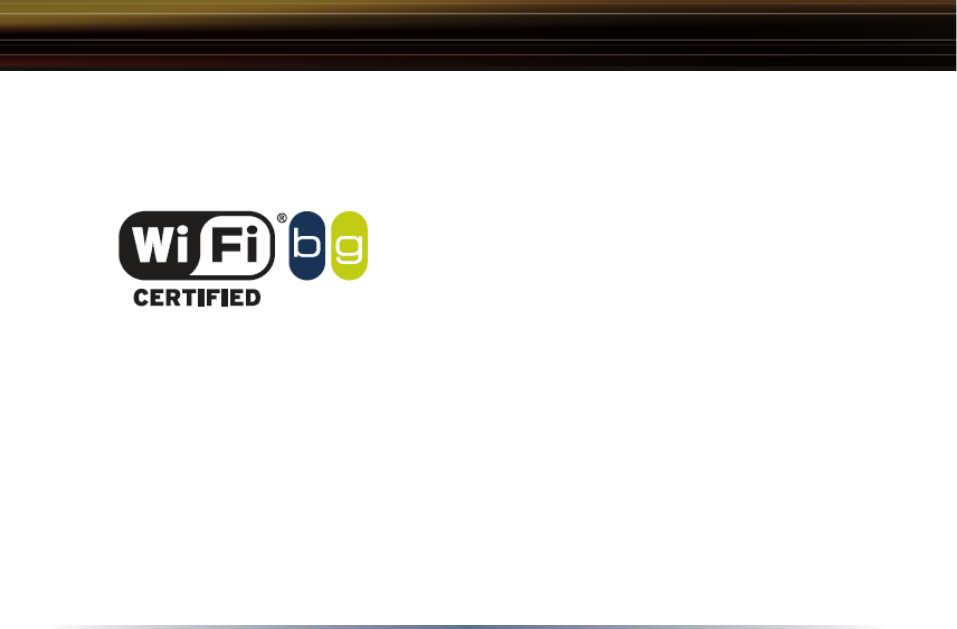
91
Certifications
This product includes the following certification(s):

92
Federal Communication Commission Interference Statement
This equipment has been tested and found to comply with the limits for a Class B digital device,
pursuant to Part 15 of the FCC Rules. These limits are designed to provide reasonable protection
against harmful interference in a residential installation. This equipment generates, uses and can
radiate radio frequency energy and, if not installed and used in accordance with the instructions, may
cause harmful interference to radio communications. However, there is no guarantee that interference
will not occur in a particular installation. If this equipment does cause harmful interference to radio
or television reception, which can be determined by turning the equipment off and on, the user is
encouraged to try to correct the interference by one of the following measures:
• Reorient or relocate the receiving antenna.
• Increase the separation between the equipment and receiver.
• Connect the equipment into an outlet on a circuit different from that to which the receiver is con-
nected.
• Consult the dealer or an experienced radio/TV technician for help.
FCC Caution: To assure continued compliance, (example - use only shielded interface cables when
connecting to computer or peripheral devices). Any changes or modifications not expressly approved
by the party responsible for compliance could void the user’s authority to operate this equipment.
This device complies with Part 15 of the FCC Rules. Operation is subject to the following two conditions:
(1) This device may not cause harmful interference, and (2) this device must accept any interference
received, including interference that may cause undesired operation.
FCC / CE Information

93
IMPORTANT NOTE:
Federal Communication Commission Interference Statement
This equipment has been tested and found to comply with the limits for a Class B digital device,
pursuant to Part 15 of the FCC Rules. These limits are designed to provide reasonable protection
against harmful interference in a residential installation. This equipment generates, uses and can
radiate radio frequency energy and, if not installed and used in accordance with the instructions, may
cause harmful interference to radio communications. However, there is no guarantee that interference
will not occur in a particular installation. If this equipment does cause harmful interference to radio
or television reception, which can be determined by turning the equipment off and on, the user is
encouraged to try to correct the interference by one of the following measures:
-Reorient or relocate the receiving antenna.
-Increase the separation between the equipment and receiver.
-Connect the equipment into an outlet on a circuit different from that
to which the receiver is connected.
-Consult the dealer or an experienced radio/TV technician for help.
This device complies with Part 15 of the FCC Rules. Operation is subject to the following two conditions:
(1) This device may not cause harmful interference, and (2) this device must accept any interference
received, including interference that may cause undesired operation.
FCC Caution: Any changes or modifications not expressly approved by the party responsible for
compliance could void the user’s authority to operate this equipment.
FCC / CE Information

94
FCC RF Radiation Exposure Statement:
This equipment complies with FCC radiation exposure limits set forth for an uncontrolled environment.
This equipment should be installed and operated with minimum distance 20cm between the radiator &
your body. This transmitter must not be co-located or operating in conjunction with any other antenna
or transmitter.
BUFFALO declared that WZR-HP-G54 is limited in CH1~11 by specified firmware controlled in
USA.
Safety
This equipment is designed with the utmost care for the safety of those who install and use it.
However, special attention must be paid to the dangers of electric shock and static electricity when
working with electrical equipment. All guidelines of this manual and of the computer manufacturer
must therefore be allowed at all times to ensure the safe use of the equipment.
EU Countries intended for use
The ETSI version of this device is intended for home and office use in Austria, Belgium, Denmark,
Finland, France (with Frequency channel restrictions), Germany, Greece, Iceland, Ireland, Italy,
Luxembourg, Norway, The Netherlands, Portugal, Spain, Sweden, Switzerland and United
Kingdom.
The ETSI version of this device is also authorized for use in EFTA member states Iceland,
Liechtenstein, Norway and Switzerland.
EU Countries Not intended for use
None.
Potential restrictive use
FCC / CE Information

95
Warranty Information
Buffalo Technology (Melco Inc.) products comes with a two-year limited warranty from the date of
purchase. Buffalo Technology (Melco Inc.) warrants to the original purchaser the product; good operat-
ing condition for the warranty period. This warranty does not include non-Buffalo Technology (Melco
Inc.) installed components. If the Buffalo product malfunctions during the warranty period, Buffalo
Technology/(Melco Inc.) will, replace the unit, provided the unit has not been subjected to misuse,
abuse, or non-Buffalo Technology/(Melco Inc.) authorized alteration, modifications or repair.
All expressed and implied warranties for the Buffalo Technology (Melco Inc) product line including,
but not limited to, the warranties of merchantability and fitness of a particular purpose are limited in
duration to the above period.
Under no circumstances shall Buffalo Technology/(Melco Inc.) be liable in any way to the user for
damages, including any lost profits, lost savings or other incidental or consequential damages arising
out of the use of, or inability to use the Buffalo products.
In no event shall Buffalo Technology/(Melco Inc.) liability exceed the price paid for the product from
direct, indirect, special, incidental, or consequential damages resulting from the use of the product, its
accompanying software, or its documentation. Buffalo Technology/(Melco Inc.) does not offer refunds
for any product.
@ 2003 Buffalo Technology (Melco, Inc.)

96
Contact Information
ADDRESS
Buffalo Technology (USA), Inc.
4030 West Braker Lane, Suite 120
Austin, TX 78759-5319
GENERAL INQUIRIES
Monday through Friday
8:30am-5:30pm CST
Direct: 512-794-8533 | Toll-free: 800-456-9799 | Fax: 512-794-8520 | Email: sales@buffalotech.
com
TECHNICAL SUPPORT
North American Technical Support by phone is available 24 hours a day, 7 days a week. (USA and
Canada).
Toll-free: (866) 752-6210 | Email: info@buffalotech.com
* When operating in High-Speed Mode, this Wi-Fi device achieves an actual throughput of up to 34.1 Mbps, which is the
equivalent throughput of a system following 802.11g protocol and operating at a signaling rate of 125* Mbps.

97
Technical Support is available 24 hours a day, 7 days a week
(USA / Canada)
Toll-Free: 866-752-6210
email: info@buffalotech.com
©2005, Buffalo Technology (USA), Inc.
4030 W. Braker Ln. Suite 120
Austin, Texas 78759
Tel: 800-456-9799
Fax: 512-794-8606